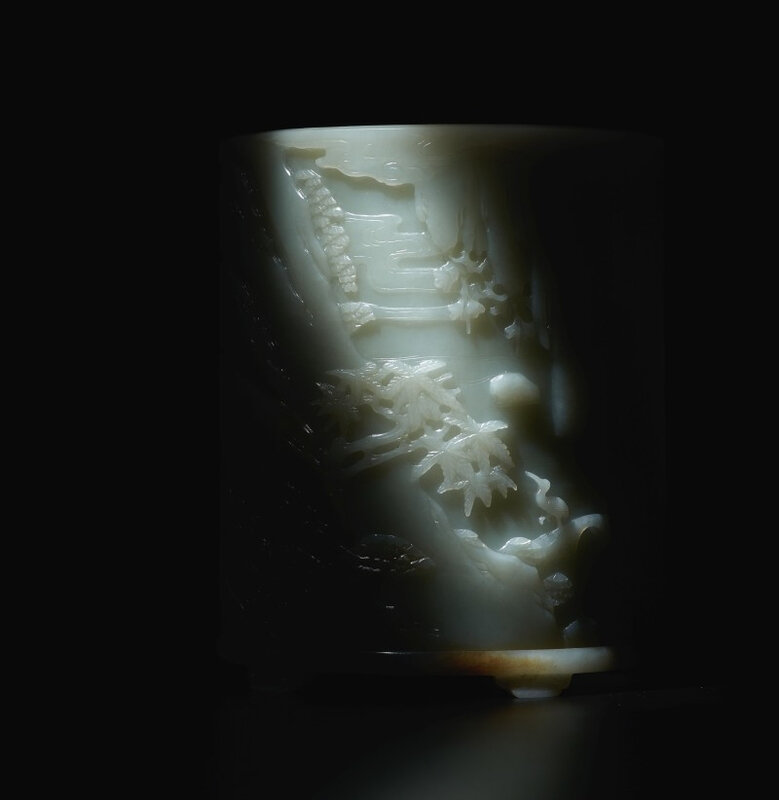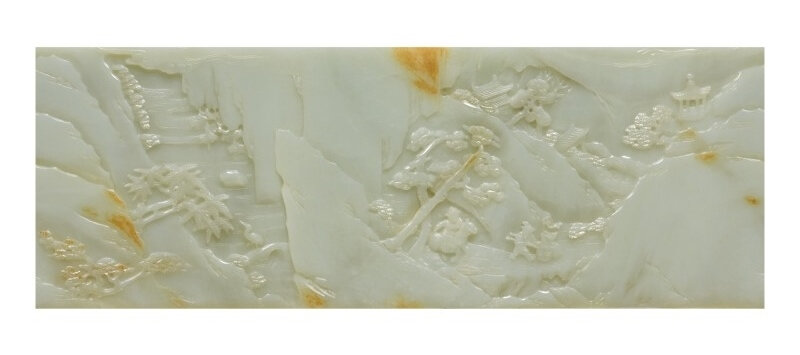An exceptional white and russet jade brushpot, Qing dynasty, Qianlong period (1736-1795)
Lot 14. An exceptional white and russet jade brushpot, Qing dynasty, Qianlong period (1736-1795). Height 7 ⅜ in., 18.7 cm. Estimate: 1,000,000 - 1,500,000 USD. Lot sold: 1,351,000 USD. (C) 2021 Sotheby's
of cylindrical form raised on five splayed ruyi-form feet, deftly carved in varying levels of relief with a continuous landscape enclosing a single scholar mounted on horseback preceded by an attendant pushing a wheeled cart surmounted by a songbird, the group traversing a narrow ravine with steep rockfaces rising to either side, the expansive surrounding landscape dotted with tiered pavilions and overhanging pine and wutong trees, to one side the rocks part to reveal a gentle creek crossed by an arched bridge supporting a single egret raised on one leg, large expanses of the surface left uncarved to express the pure white coloration of the stone, occasionally enhanced with patches of russet staining.
Literature: John Getz, The Woodward Collection of Jades and Other Hard Stones, New York, 1913, pl. 72.
killfully carved with a scene that unravels like a scroll painting with the turning of the vessel, this magnificent brush pot captures a sense of harmony and ethereality by balancing the object with the void, intricate detail with polished surfaces. The exceptional quality of the stone is highlighted through the minimally carved areas, enhanced with patches of russet staining. As light passes through the varying depths of the translucent material, it creates dramatic and mysterious contrasts within the diorama. The decoration follows in the tradition of Chinese painting, treating the surface of the material as a horizontal scroll. The motif unfolds in front of the viewer as the brushpot is turned and with each scene a new perspective of the landscape is revealed, making the brushpot an object that can be appreciated from multiple vantage points.
Objects created specifically for use on the scholar's desks can be traced to at least as early as the Han dynasty, although the full repertoire of jade scholars' objects was developed during the mid- to late Ming dynasty, and by the Qing dynasty had come to include brushpots, brush rests, wrist rests, brushes, brush washers, water droppers, scroll and paperweights, as well as larger objects for display on the desk. Many of these pieces would have been kept in the scholar's studio for use when composing calligraphy or painting; others served no particular purpose except for the personal enjoyment of the owner, as well as his select invited audience.
Whilst the earliest extant jade brushpots are known from the Ming dynasty, it was only from the mid-Qianlong period on, as the supply of raw jade from Khotan to the court became ample and reliable, that they were produced in increased in quantity. Jade brushpots, particularly those of this size, required raw jade that was not only relatively large but also free from too many blemishes, chips, and other imperfections. Consequently, jade brushpots were rarer and more valuable than those made from bamboo, wood or porcelain, and tended to be concentrated in the collections of the imperial family and other nobility. The Palace Museum Collection contains approximately 200 jade brush pots dating to the mid-Qing and later, and most of these postdate the mid-Qianlong period. These were created by the Zaobanchu (Palace Workshop), the Suzhou Manufactory, and under the supervision of the Lianghuai Salt Administration, or sent as tributes by local officials.
A painted picture may disappear as time passes, but a solid [i.e. jade] work can hardly be destroyed even after a thousand years - EMPEROR QIANLONG, 1787
The natural world had a keen grip on the imaginations of the literati who, unable to live in the arcadian natural environments they wrote of, could only seek to bring the outside world into their studios. Such miniaturization of nature, such as the immense landscape diorama enveloping the present brushpot, is commonly found in the scholarly arts of the Qing period. Furthermore, many of the scholar's objects fashioned during the Qianlong period have a certain pictorial quality, where the surface of the jade was treated as a 'canvas' for a painting. During the middle and later parts of the Qianlong Emperor's reign, he vigorously promoted the use of painterly subject matter in jade carving and insisted that carved jade should carry the spirit of the works of famous painters. Consequently, many themes common in classical Chinese painting and calligraphy began to appear in jade carvings, which either were inspired by pictorial prototypes or directly reproduced works of painting and calligraphy in the same way as stone stelae. The motivation behind such instruction lies in the commemorate poem the Emperor wrote for the famous Jade Mountain with Great Yu Controlling the Waters, completed in 1787, which is inscribed: “a painted picture may disappear as time passes, but a solid [i.e. jade] work can hardly be destroyed even after a thousand years.”
Under the Qianlong Emperor’s auspices, the jade brushpot became an important medium for pictorial subjects. Its cylindrical form yielded a suitably large, continuous, and regular pictorial surface, as could be seen already on many bamboo and wood brushpots. Through the various techniques of high- and low-relief carving, openwork, incision, and drilling, craftsmen realized an increasing quantity of compositions with figures in landscapes on jade brushpots. Possessing not only the continuity of a scroll painting but also the volumetric illusion of sculpture, these brushpots embody the aesthetic sensibilities of the literati.
Many of these 'pictorial' brushpots faithfully illustrate historical events or stories as memorialized in classical paintings, whilst others interpret their source material innovately, aiming to capture the spirit of China's rich tradition of landscape painting. A number of brushpots similarly supported on ruyi feet and carved with ethereal landscapes inhabited by figures are known from important museums and private collections; for example compare three large white jade brushpots similarly carved with large expanses of rock highlighting the flawless beauty of the material: the first formerly in the collection of Heber R. Bishop, and now in the collection of the Metropolitan Museum of Art, New York, accession no. 02.18.623; the second from the Dr. Ernest Vio and Alan and Simone Hartman collections sold at Christie's Hong Kong, 27th November 2007, lot 1518; the third from the T.B. Kitson Collection, twice sold in our London rooms, 18th October 1960, lot 152, and again 6th December 1994, lot 71.
Many of these 'pictorial' brushpots faithfully illustrate historical events or stories as memorialized in classical paintings, whilst others interpret their source material innovately, aiming to capture the spirit of China's rich tradition of landscape painting. A number of brushpots similarly supported on ruyi feet and carved with ethereal landscapes inhabited by figures are known from important museums and private collections; for example compare three large white jade brushpots similarly carved with large expanses of rock highlighting the flawless beauty of the material: the first formerly in the collection of Heber R. Bishop, and now in the collection of the Metropolitan Museum of Art, New York, accession no. 02.18.623; the second from the Dr. Ernest Vio and Alan and Simone Hartman collections sold at Christie's Hong Kong, 27th November 2007, lot 1518; the third from the T.B. Kitson Collection, twice sold in our London rooms, 18th October 1960, lot 152, and again 6th December 1994, lot 71.
Other related jade brushpots include one in the Palace Museum, Beijing, illustrated in The Complete Collection of Treasures of the Palace Museum. Jadeware (III), Hong Kong, 1995, pl. 167; one from the collection of Ernest James Wythes, sold in our London rooms, 12th May 2012, lot 29; another from the Bishop Collection, sold in these rooms, 16th September 2009, lot 251; a spinach-green jade brushpot of this type, reputedly from the Fogg Art Museum, Cambridge, sold in the same rooms, 18th March 2008, lot 16; and a slightly smaller example, dated to 1795, sold in our Hong Kong rooms, 31st October 2004, lot 229. Compare also a slightly later white jade brushpot from the Art Institute of Chicago, also sold in these rooms, 20th March 2019, lot 574.

/https%3A%2F%2Fprofilepics.canalblog.com%2Fprofilepics%2F1%2F0%2F100183.jpg)
/https%3A%2F%2Fstorage.canalblog.com%2F03%2F02%2F119589%2F96711876_o.jpg)
/https%3A%2F%2Fstorage.canalblog.com%2F11%2F31%2F119589%2F94773502_o.jpg)
/https%3A%2F%2Fstorage.canalblog.com%2F20%2F83%2F119589%2F94772815_o.jpg)
/https%3A%2F%2Fstorage.canalblog.com%2F26%2F72%2F119589%2F75604929_o.jpg)
/https%3A%2F%2Fstorage.canalblog.com%2F59%2F60%2F119589%2F26458628_o.jpg)













/http%3A%2F%2Fstorage.canalblog.com%2F89%2F26%2F119589%2F129685724_o.jpg)
/http%3A%2F%2Fstorage.canalblog.com%2F81%2F03%2F119589%2F127882199_o.jpg)
/http%3A%2F%2Fstorage.canalblog.com%2F89%2F21%2F119589%2F126661927_o.jpg)
/http%3A%2F%2Fstorage.canalblog.com%2F48%2F83%2F119589%2F126640483_o.jpg)